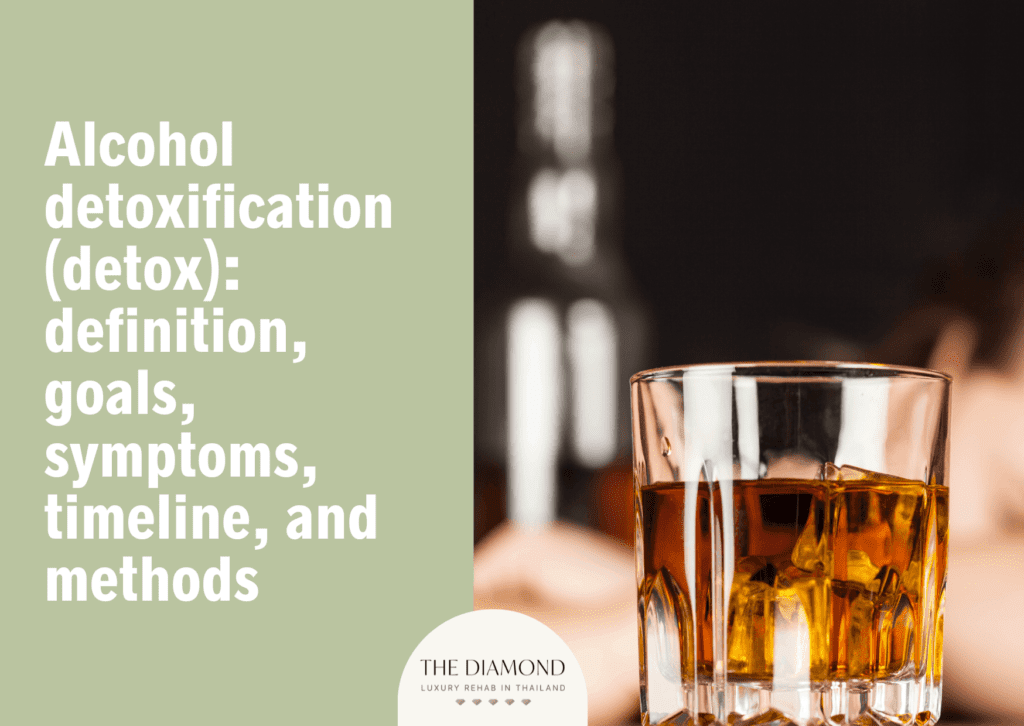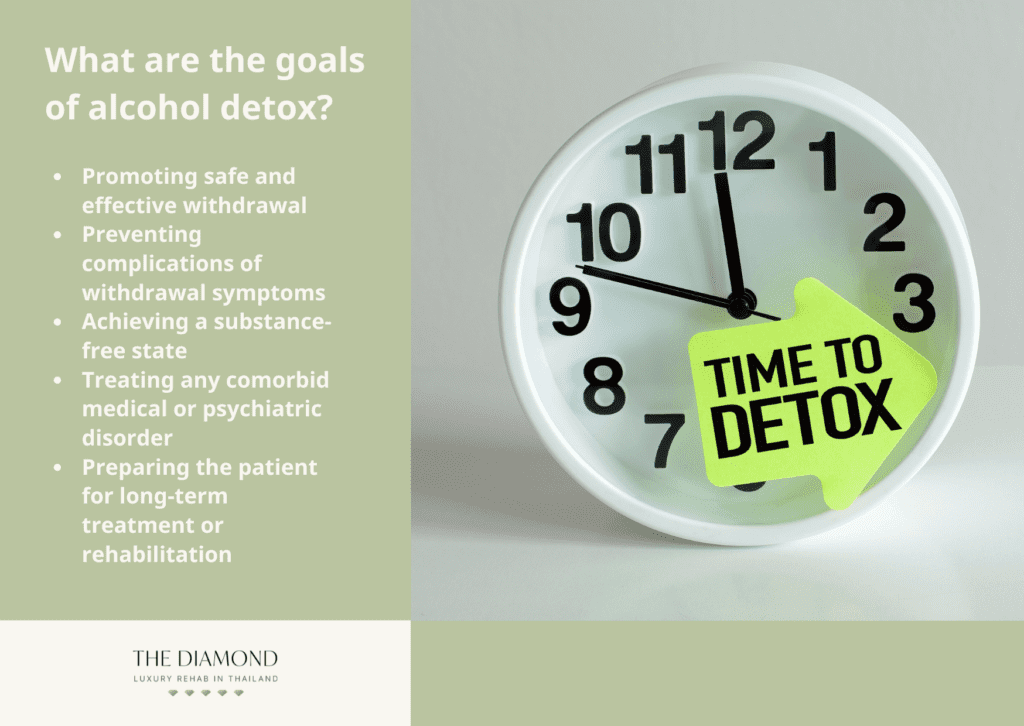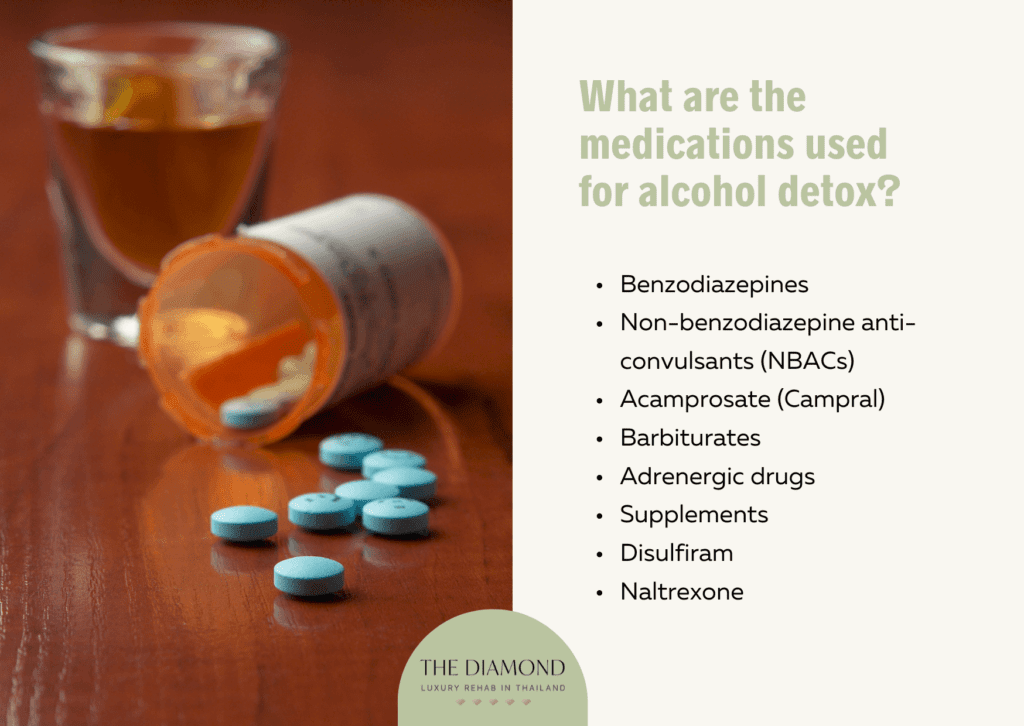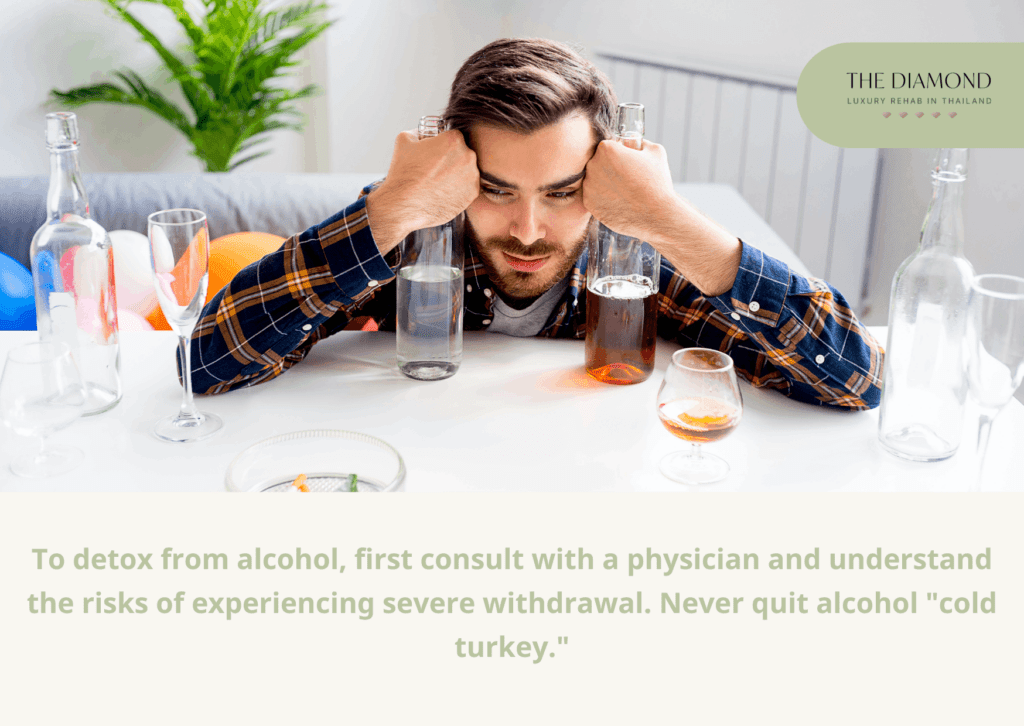Alcohol detoxification (detox): definition, goals, symptoms, timeline, and methods

Alcohol detoxification (detox) refers to the medical treatment of a patient to help them safely and effectively manage the withdrawal syndrome that arises from their physiological and psychological dependence on alcohol. It is the first step in the process of alcohol addiction recovery and the therapeutic interventions include medication and psychotherapy.
The goals of alcohol detox include promoting safe and effective withdrawal by reducing the severity of withdrawal symptoms; preventing medical and neurological complications; achieving a substance-free state; treating co-occurring physical and/or psychiatric disorders; and preparing the patient for long-term rehabilitation that promotes and sustains abstinence.
The symptoms of alcohol detoxification include headaches, tremors, anxiety, nausea, sleep disturbances, excessive sweating, hyperthermia, fast heart rate, gastrointestinal complications, hallucinations, seizures, and delirium tremens. The timeline of alcohol detox comprises these four periods beginning after alcohol cessation: 6-12 hours, 12-24 hours, 24-48 hours, and 48-72 hours. The methods of alcohol detoxification are quitting “cold turkey,” tapering off, and undergoing medically supervised detox.
What is alcohol detoxification (detox)?
Alcohol detoxification (detox) is a medically supervised and managed process where a patient is helped to overcome their physiological and psychological dependence on alcohol, according to Motoi Hayashida in the 1998 article titled “An Overview of Outpatient and Inpatient Detoxification” published in the journal Alcohol Health and Research World.” It is the first step in the journey to recovering from alcoholism.
During detoxification, alcohol is flushed out of the body. The treatment regimen involves the administration of medications and the provision of general supportive care to manage withdrawal symptoms, alongside the delivery of counseling services. The brain and the body of individuals with alcohol addiction or alcohol dependence become accustomed to the presence of the substance and systems, such as the central nervous system (CNS), adapt and change to maintain normal physiological functionality. The absence of alcohol during detoxification causes nervous system hyperactivity, which manifests as alcohol withdrawal syndrome.
Individuals go through alcohol detox because they are motivated to achieve abstinence and improve their health by cutting down the risks of alcohol use, after being pressured by their loved ones to adopt a healthier lifestyle, or due to difficulty in obtaining alcohol, according to a 2015 article by Sachdeva et al., published in the Journal of Clinical & Diagnostic Research, titled “Alcohol Withdrawal Syndrome: Benzodiazepines and Beyond.”
What is the difference between alcohol detox and alcohol withdrawal?
The difference between alcohol detox and alcohol withdrawal lies in the nature of these two processes. Alcohol detox is a therapeutic component of alcohol addiction recovery where an individual, usually a person who consumes alcohol excessively or is a long-term user, stops drinking to reduce or eliminate alcohol from their body to promote healing and attain abstinence.
Alcohol withdrawal is a possible physiological and/or psychological consequence of a person with alcohol dependence or addiction undergoing detoxification. Alcohol withdrawal manifests as a cluster of unpleasant symptoms that appear when the body accustomed to having alcohol has to adjust to having less of the substance or none at all.
Is alcohol detoxification a part of alcohol addiction recovery?
Yes, alcohol detoxification is a part of alcohol addiction recovery. It is the first step in treating alcohol dependence and alcoholism. Completing a detox program ensures that alcohol is completely flushed out of the body so that the individual is able to achieve optimal levels of health, energy, and immunity needed to heal and recover. Stopping the consumption of alcohol enables an individual to improve their mental health and regain clarity so that they are able to focus on the processes and goals of addiction recovery.
What are the goals of alcohol detox?

The goals of alcohol detox are listed below.
- Promoting safe and effective withdrawal: Detoxification aims to promote safe and effective withdrawal from alcohol by treating and minimizing the severity of withdrawal symptoms, according to a 2013 article by Shivanand Kattimani and Balaji Bharadwaj published in the Industrial Psychiatry Journal, titled “Clinical management of alcohol withdrawal: A systematic review.” For instance, medications like benzodiazepines are administered to ease specific withdrawal symptoms. Fluid and electrolyte imbalances are corrected immediately. Adequate sedation is provided to soothe the patient and if required, physical restraints are placed to prevent injuries during a state of agitation, which is a common symptom of alcohol withdrawal.
- Preventing complications of withdrawal symptoms: A clinical diagnosis of alcohol withdrawal must be followed by periodic reviews of the patient’s condition to check for signs of medical and/or neurological complications that they had not presented with but are likely to develop subsequently (Kattimani and Bharadwaj, 2013). So, during detoxification, benzodiazepines are prescribed to reduce the risk of severe alcohol withdrawal symptoms like seizures. Vitamin B supplements are administered to prevent Wernicke’s encephalopathy.
- Achieving a substance-free state: A substance-free state is achievable by reducing cravings and if feasible, admitting the patient to an inpatient facility where they do not have access to alcohol. Drugs like disulfiram and acamprosate help reduce cravings. Detoxification aims to achieve this state in a more humane way (Kattimani and Bharadwaj, 2013).
- Treating any comorbid medical or psychiatric disorder: Concurrent therapies to treat co-occurring physical or psychiatric disorders administered during detox help patients heal quickly. For instance, symptoms of mental health disorders like stress and anxiety, and the presence of psychiatric illnesses like bipolar disorder, depression, post-traumatic stress disorder, and schizophrenia increase the risk of excessive alcohol use and hinder abstinence.
- Preparing the patient for long-term treatment or rehabilitation: The ultimate goal of detoxification is to prepare the patient for long-term treatment. This goal is achieved by managing the acute symptoms of alcohol withdrawal, achieving a substance-free state, and treating co-occurring physiological and/or psychiatric illnesses, according to Motoi Hayashida in the 1998 article titled “An Overview of Outpatient and Inpatient Detoxification” published in the journal Alcohol Health and Research World.” Long-term rehabilitative care aims to optimize a patient’s chances of remaining alcohol-free and sustaining abstinence by integrating psychological, social, and family interventions.
How does alcohol detox work?
Alcohol detox works by eliminating alcohol from the body, a process that starts after having the last drink. Chronic abuse of alcohol changes the balance of neurotransmitters in the central nervous system.
Consuming alcohol triggers the production of GABA (Gamma-Aminobutyric Acid), an inhibitory neurotransmitter that dampens neuronal activity throughout the nervous system and produces the clinical effects of alcohol consumption like sedation. To maintain a natural balance, the nervous system compensates by triggering the release of glutamate, which is excitatory in nature. When alcohol is withdrawn during detox, the presence of GABA diminishes creating a condition where there is an excess of glutamate, as explained in a StatPearls [Internet] release authored by Canver et al., titled “Alcohol Withdrawal Syndrome” and last updated on 14 February 2024.
The presence of excess glutamate excites the autonomic nervous system and triggers the withdrawal symptoms commonly exhibited during alcohol detox. Medications have to be administered during alcohol detox to manage and treat more severe symptoms that do not subside on their own.
What are the symptoms of alcohol detoxification?
The symptoms of alcohol detoxification are listed below.
- Headaches: Mild headaches usually appear within 6-12 hours of having the last drink. They peak by the third day of withdrawal and begin to lessen in severity from the fourth day.
- Tremors: Tremors and alcohol “shakes” usually peak at 24 to 48 hours after having the last drink. These are uncontrollable and painful. Alcohol is a CNS depressant. Withdrawal tremors are the result of the brain exhibiting heightened activity after the CNS-depressing effects of alcohol start to wear off.
- Anxiety, agitation, or irritability: These symptoms are the result of a dysregulation of the nervous system and are considered clinically significant features of alcohol withdrawal that increase the risk of relapse, according to a 2014 article by Howard C. Becker and Patrick J. Mulholland published in the Handbook of Clinical Neurology, titled “Neurochemical Mechanisms Of Alcohol Withdrawal.”
- Nausea: Mild symptoms of alcohol detoxification like nausea appear within 6-12 hours of having the last drink, according to a 2015 article by Sachdeva et al., published in the Journal of Clinical & Diagnostic Research, titled “Alcohol Withdrawal Syndrome: Benzodiazepines and Beyond.”
- Insomnia: Symptoms of insomnia appear within 6-12 hours of stopping alcohol. It is a common symptom of alcohol withdrawal and is known to persist even after weeks and months of abstinence. Untreated insomnia increases the risk of relapsing within the first several months of recovery, according to a 2007 article by Arnedt et al., published in the Journal of Addictive Diseases, titled “Treatment Options For Sleep Disturbances During Alcohol Recovery.”
- Profuse sweating: This symptom appears 6-12 hours after cessation of alcohol and is believed to be caused by a hyperactive autonomic nervous system. Excessive sweating and fever during alcohol withdrawal increase the risk of the patient developing dehydration and its accompanying medical consequences.
- Hyperthermia: Thiamine deficiency is common among people who consume alcohol excessively. Hyperthermia or unusually high core body temperature during alcohol withdrawal is believed to be due to dysregulation of the thermal centers in the nervous system, caused by thiamine deficiency, according to a 1989 article by Bercault et al., published in the journal La Revue de Médecine Interne, titled “[Malignant hyperthermia during alcohol withdrawal].“
- Gastrointestinal complications: The gastrointestinal disturbances of alcohol withdrawal include abdominal pain and upset stomach.
- Tachycardia: Tachycardia, a condition where the heart rate is over 100 beats per minute, is an early sign of alcohol withdrawal and usually appears within 6-12 hours of having the last drink.
- Hallucinations: Visual, auditory, or tactile hallucinations usually appear within 12-24 hours of the last drink (Sachdeva et al., 2015). These symptoms are regarded as a severe manifestation of alcohol withdrawal syndrome. Hallucinations typically subside within 48 hours of stopping alcohol, according to a StatPearls [Internet] release authored by Canver et al., titled “Alcohol Withdrawal Syndrome” and last updated on 14 February 2024.
- Seizures: Alcohol withdrawal seizures appear 24-48 hours after having the last drink (Sachdeva et al., 2015). The symptoms include shaking of the limbs and loss of consciousness, and it is possible that the convulsions are not preceded and/or accompanied by other signs of withdrawal, according to a 1998 article by Richard Saitz published in the journal Alcohol Health and Research World, titled “Introduction to Alcohol Withdrawal.” This is a severe withdrawal symptom that is common in patients who are heavy drinkers.
- Delirium tremens: Delirium tremens (DTs) is a severe and life-threatening development and appears within 48-72 hours of stopping alcohol. The symptoms include hallucinations that are primarily visual in nature, disorientation, agitation, and profuse sweating (Sachdeva et al., 2015). The presence of DTs is a medical emergency and requires treatment and monitoring at an inpatient facility.
What is the timeline of alcohol detoxification?
The timeline of alcohol detoxification spans the following four periods starting after an individual has had their last drink: 6-12 hours, 12-24 hours, 24-48 hours, and 48-72 hours. Minor symptoms like insomnia, headaches, profuse sweating, gastrointestinal disturbances, anxiety, and elevated heart rate appear within 6-12 hours of alcohol cessation, according to a 2004 article by Bayard et al., published in the journal American Family Physician, titled “Alcohol Withdrawal Syndrome.”
Hallucinations typically appear within 12-24 hours while seizures tend to appear within 24-48 hours of having the last drink. Symptoms like delirium tremens appear about 48-72 hours after stopping alcohol. Factors like the duration and frequency of alcohol use, the amount consumed, the presence of co-occurring medical and psychiatric disorders, and concurrent use of other substances influence the timeline of alcohol detoxification.
How long does it take to detox from alcohol?
It takes, on average, 7-10 days to detox from alcohol. The initial detox lasts about a week. Specific symptoms start to increase in severity toward the end of the first 24 hours of stopping alcohol and the distress caused by the deteriorating symptoms last into the second day of detox. After 5-7 days, the severity of the symptoms begins to decrease. However, patients are known to experience post-acute withdrawal syndrome (PAWS) characterized by prolonged symptoms of detox. These symptoms include depleted energy levels, anxiety, insomnia, and delayed reflexes and are known to last for several months and up to a year.
What happens after alcohol detoxification?
After alcohol detoxification, patients prepare to enter into long-term treatment or rehabilitation, which is the ultimate objective of detoxification. The goals of rehabilitation are maintenance of sobriety and the delivery of psychological, physical, family, and social interventions to support abstinence, according to Motoi Hayashida in the 1998 article titled “An Overview of Outpatient and Inpatient Detoxification” published in the journal Alcohol Health and Research World. A section of patients undergo treatment for alcohol addiction and co-occurring medical and psychiatric disorders, according to a 1998 article by Richard Saitz published in the journal Alcohol Health and Research World, titled “Introduction to Alcohol Withdrawal.”
The outcome of alcohol detoxification is largely dependent on patient demographics (Hayashida, 1998). On average, one-third to one-half of patients relapse and restart abusing alcohol six months after undergoing alcohol detoxification. Factors present at the initiation of detoxification like the psychiatric and physical health of the patient, concurrent drug use, legal and employment status, and quality of familial relationships determine the outcome of alcohol detoxification.
What are the alcohol detox methods?

The alcohol detox methods are listed below.
- Quitting alcohol “cold turkey:” Quitting alcohol “cold turkey” means stopping the consumption of alcohol abruptly and completely. It is a dangerous procedure for individuals with alcohol dependence whose bodies have become accustomed to the presence of alcohol and react to abrupt cessation of drinking by producing severe and potentially life-threatening withdrawal symptoms. Factors like the duration and frequency of drinking, the presence of co-occurring disorders, and the patient’s baseline physical health determine whether it is safe for them to stop using alcohol abruptly. A physician should determine if an individual should attempt to quit alcohol “cold turkey.” People choose to quit alcohol “cold turkey” with the intention to abstain from the substance immediately and absolutely. However, it is worth noting that abstinence is not the only way to treat alcoholism, according to a 2021 article by Henssler et al., published in the journal Addiction titled “Controlled drinking-non-abstinent versus abstinent treatment goals in alcohol use disorder: a systematic review, meta-analysis, and meta-regression.” Controlled drinking, especially if supported by psychotherapy, is an effective way of treating alcohol use disorder.
- Tapering off alcohol: Tapering off is a slower process of stopping alcohol use than quitting cold turkey and reduces the likelihood of experiencing severe withdrawal symptoms and relapsing. It involves drinking less alcohol each day to let the body get accustomed to having less of the substance. Tapering off alcohol works for individuals who are unwilling to attend a full detoxification program, have a low risk of experiencing withdrawal symptoms, or have access to medical professionals at home. Heavy drinkers of alcohol should always seek advice from a medical professional before attempting to taper off because they have an increased risk of experiencing severe and potentially life-threatening withdrawal symptoms.
- Medically supervised detox: Going through a medically supervised detox in an outpatient or inpatient facility is always safe, especially for individuals with severe physiological or psychological dependence on alcohol. Medically supervised detox is carried out under the guidance and supervision of a licensed medical practitioner. According to Motoi Hayashida in the 1998 article titled “An Overview of Outpatient and Inpatient Detoxification” published in the journal Alcohol Health and Research World, besides assessing and treating acute withdrawal symptoms, a medically supervised detox program includes additional therapy components like counseling and education.
What is the safest way to detox from alcohol?
The safest way to detox from alcohol is in an inpatient detoxification setting, according to a 2015 article by Sachdeva et al., published in the Journal of Clinical & Diagnostic Research, titled “Alcohol Withdrawal Syndrome: Benzodiazepines and Beyond.” Treatment at an inpatient detox setting takes place under continuous medical supervision and the patient is promptly and appropriately supported if complications arise. Inpatient detox facilities provide superior continuity of care to patients compared to outpatient clinics. Detoxing while being admitted to an inpatient facility allows them to recover in the absence of alcohol-related environmental and social cues, which reduces the risk of relapsing.
Can alcohol detoxification be done at home?
Yes, alcohol detoxification can be done at home if the individual does not possess a history of experiencing severe withdrawal symptoms or complications like seizures and delirium tremens, has not been drinking heavily in the recent past, and does not have a diagnosis of a co-occurring severe psychiatric or medical illness, according to a 2015 article by Sachdeva et al., published in the Journal of Clinical & Diagnostic Research, titled “Alcohol Withdrawal Syndrome: Benzodiazepines and Beyond.”
Only fewer than 20 percent of patients undergoing alcohol detoxification need to be admitted to an inpatient facility. Depending on their withdrawal symptoms, the rest of the patients are provided with supportive care at an outpatient facility and observed for up to 36 hours before being sent home.
What are the medications used for alcohol detox?

The medications used for alcohol detox are listed below.
- Benzodiazepines: Benzodiazepines are prescribed to prevent complications and/or symptoms like agitation, seizures, and delirium tremens, according to a 2015 article by Sachdeva et al., published in the Journal of Clinical & Diagnostic Research, titled “Alcohol Withdrawal Syndrome: Benzodiazepines and Beyond.” The decision to use a long-acting or a short-acting form of benzodiazepine depends on the presence of underlying medical conditions in the patients and their individual risk of developing complications when sedated.
- Non-benzodiazepine anti-convulsants (NBACs): Despite their effectiveness, benzodiazepines have significant abuse potential, carry risks of cognitive impairment and psychomotor agitation, and are known to interact with alcohol and cause unpleasant symptoms. NBACs like valproic acid (VPA) are considered to be effective benzodiazepine alternatives to manage mild to moderate alcohol withdrawal symptoms and prevent relapse, according to a 2020 article by Baqir et al., published in the journal Current Psychiatry, titled “Treating alcohol withdrawal syndrome: Going beyond ‘benzos’.” Other NBACs like gabapentin and vigabatrin are promising medications for alcohol detoxification (Sachdeva et al., 2015).
- Acamprosate (Campral): Acamprosate has been approved by the Food and Drug Administration (FDA) as a treatment for alcohol dependence. It has been suggested that the drug should be introduced earlier in treatment–during the acute detoxification phase–to prevent relapse and sustain abstinence after detoxification, according to a 2009 article by Kampman et al., published in the journal Addictive Behaviors, titled “Initiating acamprosate within-detoxification versus post-detoxification in the treatment of alcohol dependence.”
- Barbiturates: Barbiturates like phenobarbital have been shown to effectively treat withdrawal symptoms during alcohol detox. Phenobarbital is as effective as benzodiazepine and promises to be beneficial in cases involving benzodiazepine-resistant patients, individuals exhibiting severe alcohol withdrawal in an intensive care unit, and those in the emergency department, according to a 2016 article by Katherine Martin and Andrew Katz published in the journal Psychosomatics, titled “The Role of Barbiturates for Alcohol Withdrawal Syndrome.”
- Adrenergic drugs: Drugs like clonidine and propranolol are believed to be capable of significantly easing several symptoms of alcohol withdrawal like elevated pulse and blood pressure (Sachdeva et al., 2015). They hold promise as an adjunct treatment modality to a benzodiazepine protocol and are useful in outpatient settings where it is not feasible to monitor patients for benzo abuse.
- Supplements: Supplements are administered to patients who risk developing refeeding syndrome, are nutritionally deficient, have Wernike and progressive neuropsychiatric manifestations, or have alcohol-related ketoacidosis, according to a StatPearls [Internet] release authored by Canver et al., titled “Alcohol Withdrawal Syndrome” and last updated on 14 February 2024. These supplements include electrolytes, thiamine and folate supplementation, and glucose-containing fluids.
- Disulfiram: Disulfiram is an alcohol-aversive or alcohol-sensitizing drug that produces toxic and unpleasant side effects in the presence of alcohol. It is suggested that the drug promotes abstinence in the short term and increases treatment retention in patients who have undergone detoxification or are in the initial stages of abstinence, as mentioned in the chapter “Disulfiram” from a 2009 publication by the Substance Abuse and Mental Health Services Administration (SAMHSA) titled “Incorporating Alcohol Pharmacotherapies Into Medical Practice.“
- Naltrexone: Naltrexone has multiple advantages in helping patients during alcohol detox. Raymond F. Anton in a 2008 article published in The New England Journal of Medicine, titled “Naltrexone for the Management of Alcohol Dependence,” notes that naltrexone has the potential to reduce alcohol use by decreasing the pleasurable feelings produced by drinking and to sustain abstinence by lessening the cravings triggered by alcohol cues. The FDA recommends that treatment with naltrexone should be initiated after the symptoms of acute alcohol withdrawal have subsided. However, naltrexone is safe to be taken during medically supervised detox, as mentioned in the chapter “Oral Naltrexone” in the 2009 SAMHSA publication titled “Incorporating Alcohol Pharmacotherapies Into Medical Practice.“
What are the potential consequences of leaving a detoxification program early?
The potential consequences of leaving a detoxification program early are listed below.
- Development of severe medical complications: The risks of developing severe and potentially life-threatening withdrawal symptoms like seizures and hallucinations increase when a patient leaves a detoxification program early.
- Inability to achieve and/or sustain abstinence: Patients who leave a detox program early have not had the chance to learn the skills necessary to achieve or maintain sobriety. For instance, unlearning automated and maladaptive responses to alcohol cues and learning and practicing healthy coping strategies when faced with life stressors are keys to preventing relapse.
- Aggravation of negative socio-economic consequences: Inability to achieve or maintain abstinence strains personal relationships and magnifies financial burdens when the individual loses their job and/or spends excessively on alcohol.
- Increased risk of developing an addiction: Leaving a detoxification program early makes an individual vulnerable to relapsing. If an individual is unable to achieve and sustain abstinence, their pattern of unhealthy alcohol use is likely to aggravate and develop into a full-blown addiction issue.
- Worsening of co-occurring psychiatric disorders: Excessive consumption of alcohol associated with alcohol use disorder is known to contribute to several psychiatric disorders. Leaving a detoxification program early increases the risk of the patient relapsing, which, in turn, is likely to worsen the symptoms of a comorbid psychiatric condition.
How to detox from alcohol?

To detox from alcohol, first consult with a physician and understand the risks of experiencing severe withdrawal. Never quit alcohol “cold turkey.” Instead, taper off alcohol. Prepare a weekly reduction schedule; reduce the number of drinks gradually; increase the duration between each drink; drink water between drinks; and mix your preferred drinks with those with less alcohol content. Eat a balanced and nutritious diet consisting of whole foods, fruits and vegetables, lean proteins, and whole grains. Chronic alcohol use is associated with vitamin B deficiency, so eat foods rich in B vitamins during detox. Avoid sugary and processed foods. Stay hydrated.
Learn and practice relaxation techniques, such as meditation, deep breathing, and progressive muscle relaxation, to cope with the stress of withdrawal symptoms. Seek emergency medical help if withdrawal symptoms become unbearable or severe symptoms like seizures and delirium tremens appear. Alcohol detoxification should, ideally, be done under medical supervision.
How can you help someone going through alcohol detoxification?
You can help someone going through alcohol detoxification by learning about the symptoms of withdrawal and the timeline of detox so that you can provide the support they need to manage the symptoms. You should remain alert to the development and progression of symptoms and seek medical help if symptoms become severe. You must remove all alcohol cues from the living environment and avoid enabling behaviors like providing them with financial assistance that they are likely to divert to procure alcohol.
Going through alcohol detoxification is physically demanding and emotionally stressful, so you should create a calming, supportive, and non-judgmental environment where they feel emotionally validated and safe and are encouraged to share their experiences, fears, and concerns. You can offer your loved one practical assistance by helping them plan, shop for, and prepare nutritious meals and accompanying them to support group meetings.


